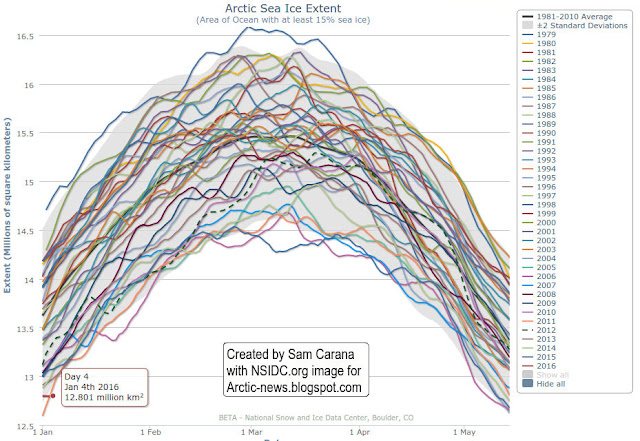Has maximum sea ice extent already been reached this year?
2016 Arctic extent ice ocean seaAn earlier post wondered whether maximum extent for this year had already been reached, i.e. on February 9, 2016, when sea ice extent was 14.214 million km2.
As illustrated by the image below, extent since has been lower, including on the two most recent days on the image, i.e. on February 16 and 17, 2016, when extent was respectively 14.208 and 14.203 million km2.
Last year (2015), maximum sea ice extent was reached on February 25. That's close to the most recent date on the image of February 17, so with El Nino still going strong, it may well be that the maximum in 2016 will be reached early.
On the other hand, strong winds could spread out the sea ice and speed up its drift out of the Arctic Ocean, which may result in a larger extent, but which won't do much to strengthen the sea ice.
UPDATES: On February 18, 2016 (arrow), Arctic sea ice extent was 14.186 million square km, i.e. less than it was on February 9. In fact, sea ice extent hasn't been higher on any day since February 9, 2016. So, the question is, has this year's maximum extent already passed us by (i.e. on February 9)?
The image below shows the heat is having a huge impact on the sea ice, with some areas (black) showing sea surface temperature anomalies above 8°C (or above 14.4°F).
Ominously, sea surface off the North American east coast was as much as 11.8°C or 21.3°F warmer on February 19, 2016, than it was in 1981-2011 (at the location marked by the green circle in the image below).
Temperatures over the Arctic Ocean are forecast to remain extremely high for the next five days, with anomalies in a large part of the Arctic Ocean at the top end of the scale, i.e. 20°C or 36°F.
As the image below shows, Arctic sea ice area was at a record low for the time of year on February 18, 2016.

The image below shows that Arctic sea ice extent on February 20, 2016, was only 14.166
million km2 (arrow), adding to fears that this year's maximum was already reached on February 9.
Meanwhile, very high methane levels, as high as 3096 parts per billion, were recorded on February 20, 2016, as shown by the image below.
Further analysis indicates that these high levels likely originated from destabilizing methane hydrates in sediments, from a location about latitude 85°North and longitude +105° (East), on the Gakkel Ridge, just outside the East Siberian Arctic Shelf, at the location of the red marker on the map below.
Below is a comparison map, from grida.no
 |
| for large-size image, go to grida.no |
 |
| zoom in and out at nullschool.net |
On February 18, 2016 (arrow), Arctic sea ice extent was 14.186 million square km, i.e. less than it was on February 9....
Posted by Sam Carana on Friday, February 19, 2016
















































